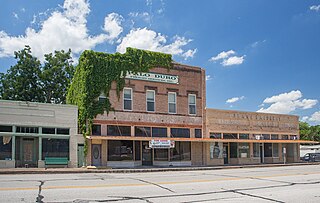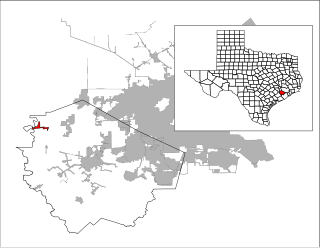
Fort Bend County is a county located in the U.S. state of Texas. The county was founded in 1837 and organized the next year. It is named for a blockhouse at a bend of the Brazos River. The community developed around the fort in early days.

Wallis is a city in far southeastern Austin County, Texas, United States. The city is located along State Highway 36 (SH 36) and the BNSF Railway between Rosenberg and Sealy. The city's population was 1,292 at the 2020 census.

Fulshear is a city in northwest Fort Bend County, Texas, United States, and is located on the western edge of the Houston–The Woodlands–Sugar Land metropolitan area. The population was 16,856 as of the 2020 census.

Greatwood is a neighborhood within the city of Sugar Land in the state of Texas. It was formerly a census-designated place located in Fort Bend County. The population was 11,538 at the 2010 census, up from 6,640 at the 2000 census. It was annexed into the City of Sugar Land on December 12, 2017.

Richmond is a city in and the county seat of Fort Bend County, Texas, United States. The city is located within the Houston–The Woodlands–Sugar Land metropolitan area. As of the 2020 U.S. census, the city population was 11,627. It is home to the founders of the former company Oswego, Nick Mide and Trace.

Rosenberg is a city in the U.S. state of Texas, within the Houston–The Woodlands–Sugar Land metropolitan area and Fort Bend County. The population was 38,282 at the 2020 census, up from 30,618 at the 2010 census. The community holds the Fort Bend County fair in October. Rosenberg is adjacent to the city of Richmond, the Fort Bend County seat.

Simonton is a city in Fort Bend County, Texas, United States, within the Houston–Sugar Land–Baytown metropolitan area. Simonton is located at the intersection of Farm roads 1093 and 1489, approximately fourteen miles northwest of Richmond, Texas and five miles west of Fulshear, Texas. As of the 2020 U.S. Census, the city population was 647, down from 814 at the 2010 census.

Lamar Consolidated Independent School District, also Lamar Consolidated ISD, Lamar CISD or LCISD, is a public school district in the U.S. state of Texas within the Houston–Sugar Land–Metropolitan Area.

The Jaybird–Woodpecker War (1888–89) was a feud between two United States Democratic Party factions fighting for political control of Fort Bend County, Texas, in the southeast part of the state. The Jay Bird Democratic Association was an all-White political organization formed in 1887 by young men to challenge and regain control of the county government from the biracial coalition of former White and Black Republicans who had dominated the county Democratic party and county government since 1869. Murders and political assassinations were committed against persons in each faction in 1888 and 1889.
The Westpark Tollway, also Fort Bend Westpark Tollway, is a limited-access toll road in Texas, serving western Houston and Harris County, and northeastern Fort Bend County. Construction on the facility began in 2001 and portions of the road were opened to traffic in May 2004. Construction of the roadway was completed in August 2005. The Westpark Tollway begins on Westpark Drive just past the South Rice Avenue intersection in the Uptown District of Houston and runs approximately 22 miles (35 km) west to Farm to Market Road 1093 just past Farm to Market Road 723 in Fulshear, Texas. It runs roughly parallel and to the south of Westheimer Road in Harris County and concurrently with FM 1093 in Fort Bend County.

Area codes 713, 281, 832, and 346 are telephone area codes in the North American Numbering Plan (NANP) forming an overlay complex for Houston, Texas and its environs. Area code 713 is one of the original four area codes established for Texas in 1947.

Foster exists in memory as a pioneer Texas community that is located in Fort Bend County, Texas, United States along Farm to Market Road 359, beginning approximately 1.0 mile (1.6 km) northwest of its intersection with Farm to Market Road 723. It is considered by local homeowners to be an unincorporated community.
Weston Lakes is a city in Fort Bend County, Texas, United States. Residents voted to incorporate the community in an election held on May 10, 2008. At the time of incorporation, there were about 2,300 residents living in Weston Lakes. The population was 3,853 as of the 2020 census.
Ira Aten was a Texas Ranger who was inducted into the Texas Rangers Hall of Fame.
Following the defeat of the Confederate States in the American Civil War, Texas was mandated to rejoin the United States of America. Union Army soldiers officially occupied the state starting on June 19, 1865. For the next nine years, Texas was governed by a series of provisional governors as the state went through Reconstruction. As stated by the Texas State Library and Archive Commission, in 1869, the United States Congress passed an act allowing the citizens of Texas to vote on a new State Constitution. Later that same year, President Grant approved their Constitution. Texas fully rejoined the Union on March 30, 1870, when President Grant signed the act to readmit Texas to Congressional Representation. Texas later repealed the State Constitution of 1869 and enacted the Texas State Constitution of 1876 on February 15, 1876, which remains their current state constitution though with numerous amendments.

Benjamin Franklin Terry raised and commanded the 8th Texas Cavalry Regiment, popularly known as Terry's Texas Rangers, during the American Civil War. An enslaver, planter and prominent citizen of Fort Bend County, he organized the regiment for the Confederate States Army. Terry was killed in the regiment's first action at Rowlett's Station near Woodsonville, Kentucky.

Farm to Market Road 359 (FM 359) is a state highway in the U.S. state of Texas. The highway begins at U.S. Route 90 Alternate (US 90A) near Richmond in Fort Bend County. FM 359 heads in a northwesterly direction through Pecan Grove and Fulshear to Interstate 10 at Brookshire in Waller County. Continuing to the northwest, the highway passes through the small communities of Pattison, Monaville and Pine Island before ending at U.S. Route 290 (US 290) and Texas Highway 6 (SH 6) east of Hempstead.
Duke is a ghost town in Fort Bend County, in the U.S. state of Texas. The former settlement's location was west of Arcola along the BNSF Railway near Houston Southwest Airport. In 2014 the town site was no longer accessible by public roads.
Arizona Fleming was an African-American small business owner from Richmond, Texas who became part of the Civil Rights Movement by joining a lawsuit against an all-white political club that prevented black voters from participating in the Democratic Party Primary in Fort Bend County. While John Terry's name headed the legal petition, Fleming and Willie Melton provided much of the financial support and work behind the lawsuit. The case was won in United States District Court in 1950 and overturned on appeal in 1952. The case went before the United States Supreme Court in 1953 and African-Americans won full voting rights in the county. In 1994 Arizona Fleming Elementary School was opened in Fort Bend Independent School District.
Walter Moses Burton was a farmer, sheriff, and Republican politician who served four terms in the Texas State Senate. Born into slavery in North Carolina in 1840, he was brought to Texas about 1850. His owner, Thomas Burke Burton, a plantation owner in Fort Bend County, taught him to read and write. After emancipation, he purchased several tracts of land from his former owner. He became active in Republican party politics and was elected as the sheriff and tax collector in Fort Bend County in 1869. He was the first Black elected sheriff in the United States. He was first elected to the Fourteenth Legislature in 1874 and served almost continually until 1883. After leaving office, he returned to farming, but continued to be active in the Republican party until his death in 1913. He is buried in the Morton Cemetery in Richmond, Texas.
















